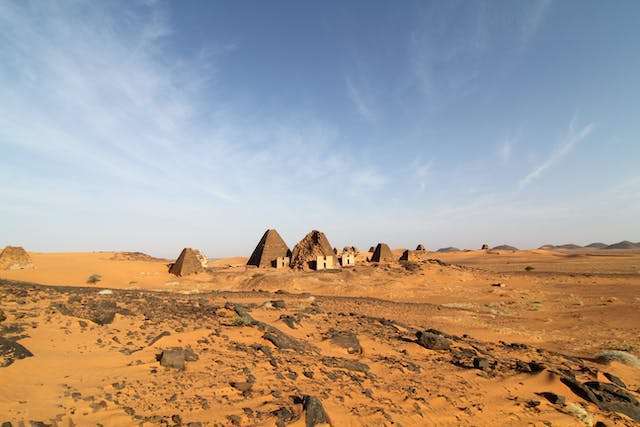Kabushiya, Sudan

The Pyramids of Meroe in Sudan are a remarkable architectural feat that has stood the test of time. These pyramids are located about 200 km northeast of Khartoum, the capital city of Sudan, and were built over 2,000 years ago. They are a testament to the rich cultural history and legacy of the people of Sudan.
The pyramids of Meroe are distinguished by their unique design, which differs from the pyramids of Egypt. They are smaller and steeper, with a more pointed shape. They are also built on a different angle, with their sides oriented towards the cardinal points of the compass.
There are more than 200 pyramids in the Meroe area, spread out over three distinct necropolises. The first necropolis is located on the east bank of the Nile, while the second and third necropolises are located on the west bank.
The pyramids were built as tombs for the kings and queens of the Kingdom of Kush, which ruled over the region from around 800 BC to 350 AD. The Kushites were known for their advanced civilization, which was centered around the city of Meroe. They were skilled in agriculture, metallurgy, and ironworking, and they traded extensively with the ancient Egyptians and other civilizations in the region.
The pyramids of Meroe are made of sandstone and granite, and they are decorated with intricate carvings and hieroglyphics. They range in size from small, single-chamber tombs to large, multi-chambered pyramids that were used to house entire royal families.
In addition to the pyramids, the Meroe area is also home to a number of other archaeological sites, including the Royal City of Meroe, which was the political and religious center of the Kingdom of Kush. The city is believed to have been a bustling metropolis, with palaces, temples, and other buildings constructed of brick and stone.
Despite their impressive size and architectural significance, the pyramids of Meroe are relatively unknown compared to their counterparts in Egypt. This is due in part to the fact that the area was not extensively excavated until the 20th century, and also because of the region’s political instability in recent decades.
However, efforts are underway to preserve and promote the pyramids of Meroe as a major tourist attraction and cultural landmark. The site was declared a UNESCO World Heritage Site in 2011, and there are plans to develop the area as a major archaeological park.
Visit
Pyramids of Meroe, Shendi-Atbara Road, Hillat Wad Saqqa, Hillat el Mashaykha, Shendi, River Nile State, Sudan
Comments